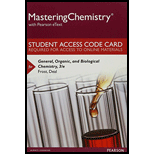
Concept explainers
a.
To convert:
The given compound into the other two structural representations that are not shown.
Introduction:
Most of the living organisms prefer an environment that has constant
b.
To convert:
The given compound into the other two structural representations that are not shown.
Introduction:
Most of the living organisms prefer an environment that has constant
c.
To convert:
The given compound into the other two structural representations that are not shown.
Introduction:
Most of the living organisms prefer an environment that has constant
Want to see the full answer?
Check out a sample textbook solution
Chapter 4 Solutions
Mastering Chemistry with Pearson eText -- Standalone Access Card -- for General, Organic, and Biological Chemistry (3rd Edition)
- Please list all the different functional groups present in the structure, excluding alkanes. List them in alphabetical order from left to right.arrow_forwardwrite the expanded structural formula and organic family of the following compoundsarrow_forwardThe following molecules only have a single functional group. Identify to which class of organic compounds each molecule belongs based on its functional group.arrow_forward
- please draw the condensed structural formula of the following compoundsarrow_forwardCharacterize the features of organic compounds?arrow_forwardGive one example of organic compound. a. Give its chemical name and chemical formula b. Structure of the organic compound (identify the functional group/s if any) c. Properties of the organic compound (physical and chemical)arrow_forward
- Classify the organic compounds by the class of their functional group.arrow_forwardConvert these structures to an expanded structural formulaarrow_forwardPlease convert the following skeletal/line drawings to full Lewis dot structures (including lone pairs). Write the formula. Identify any major functional groups in each structure.arrow_forward
- Describe the concept of an organic functional group.arrow_forwardFor the line structure of the alkane shown below write the condensed structural formula.arrow_forwardWhat is the missing reactant in this organic reaction. Specifically in the drawing area below draw the CONDENSED structure of Rarrow_forward
- Chemistry: Matter and ChangeChemistryISBN:9780078746376Author:Dinah Zike, Laurel Dingrando, Nicholas Hainen, Cheryl WistromPublisher:Glencoe/McGraw-Hill School Pub Co
 Introductory Chemistry: An Active Learning Approa...ChemistryISBN:9781305079250Author:Mark S. Cracolice, Ed PetersPublisher:Cengage Learning
Introductory Chemistry: An Active Learning Approa...ChemistryISBN:9781305079250Author:Mark S. Cracolice, Ed PetersPublisher:Cengage Learning

